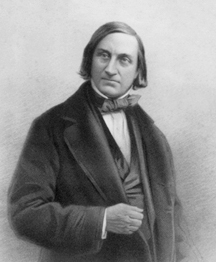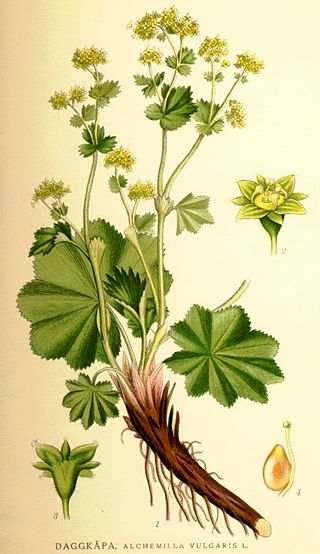
Sir William Jackson Hooker was an English botanist and botanical illustrator, who became the first director of Kew when in 1841 it was recommended to be placed under state ownership as a botanic garden. At Kew he founded the Herbarium and enlarged the gardens and arboretum. The standard author abbreviation Hook. is used to indicate this person as the author when citing a botanical name.

Acer pseudoplatanus, known as the sycamore in the British Isles and as the sycamore maple in the United States, is a species of maple native to Central Europe and Western Asia. It is a large deciduous, broad-leaved tree, tolerant of wind and coastal exposure.

Alchemilla is a genus of herbaceous perennial plants in the family Rosaceae, with the common name lady's mantle applied generically as well as specifically to Alchemilla mollis when referred to as a garden plant. The plant used as a herbal tea or for medicinal usage such as gynaecological disorders is Alchemilla xanthochlora or in Middle Europe the so-called common lady's mantle Alchemilla vulgaris. There are about 700 species, the majority native to cool temperate and subarctic regions of Europe and Asia, with a few species native to the mountains of Africa and the Americas.

Edward Forbes FRS, FGS was a Manx naturalist. In 1846, he proposed that the distributions of montane plants and animals had been compressed downslope, and some oceanic islands connected to the mainland, during the recent ice age. This mechanism, which was the first natural explanation to explain the distributions of the same species on now-isolated islands and mountain tops, was discovered independently by Charles Darwin, who credited Forbes with the idea. He also incorrectly deduced the so-called azoic hypothesis, that life under the sea would decline to the point that no life forms could exist below a certain depth.

Alchemilla alpina, commonly known as alpine lady's-mantle, is an arctic-montane herbaceous perennial plant native to Europe and Southern Greenland.

The Botanical Society of Britain and Ireland (BSBI) is a scientific society for the study of flora, plant distribution and taxonomy relating to Great Britain, Ireland, the Channel Islands and the Isle of Man. The society was founded as the Botanical Society of London in 1836, and became the Botanical Society of the British Isles, eventually changing to its current name in 2013. It includes both professional and amateur members and is the largest organisation devoted to botany in the British Isles. Its history is recounted in David Allen's book The Botanists.

Clive Anthony Stace is a British botanist and botanical author. He studied at King's College London, graduated from University of London in 1959 and then studied at the Natural History Museum, London. He was awarded a PhD in 1963. His academic career was based at the University of Leicester, where he held the post of Professor of Plant taxonomy. He is a past president of the Botanical Society of Britain and Ireland from 1987 to 1989.

Alchemilla mollis, the garden lady's-mantle or lady's-mantle, is a species of flowering plant in the family Rosaceae. This herbaceous perennial plant is native to Southern Europe and grown throughout the world as an ornamental garden plant. It grows 30 to 45 cm tall, with leaves that are palmately veined, with a scalloped and serrated margin. The stipules are noteworthy in that they are fused together and leaf like. The chartreuse yellow flowers are held in dense clusters above the foliage. A. mollis has gained the Royal Horticultural Society's Award of Garden Merit. The plant self-seeds freely and can become invasive.
The history of phycology is the history of the scientific study of algae. Human interest in plants as food goes back into the origins of the species, and knowledge of algae can be traced back more than two thousand years. However, only in the last three hundred years has that knowledge evolved into a rapidly developing science.
(Ernest) Charles Nelson is a botanist who specialises in the heather family, Ericaceae, especially Erica, and whose past research interests included the Proteaceae especially Adenanthos. He is the author or editor of over 24 books and more than 150 research papers. He was honorary editor of Archives of Natural History between 1999 and 2012 and remains closely linked with the journal as one of the Associate Editors, and was honorary editor of Heathers for 23 years until 2017.

John Scouler was a Scottish naturalist.
George Gardner was a Scottish biologist mainly interested in botany.

Haplophilus subterraneus, commonly known as the western yellow centipede is a species of centipede in the family Himantariidae that can be found in Central Europe, Ireland, Newfoundland, Scandinavia and the United Kingdom. It was recorded from a compost heap of the Botanical Garden at the University of Oslo at Teryen, Oslo in 1992 and 1995.

Alchemilla vulgaris, common name Lady's mantle, is an herbaceous perennial plant in Europe and Greenland. These perennial wildflowers, members of the rose family, are sometimes grown in gardens - mainly for their leaves, which collect sparkling water droplets.

Alchemilla arvensis, known as parsley-piert, is a sprawling, downy plant common all over the British Isles where It grows on arable fields and bare wastelands, particularly in dry sites. The short-stalked leaves have three segments each lobed at the tip. Flowers April–September. The tiny green flower has four sepals and no petals, the fruit is oval pointed. Stipules form a leaf-like cup, enclosing the flower. The name of parsley piert has nothing to do with parsley. It is a corruption of the French perce-pierre, meaning 'stone-piercer' and was given to the plant because of its habit of growing in shallow, stony soil and emerging between stones. As in the case of saxifrage it was wrongly assumed that the plant could pierce stones; and it was thought that a medicine made of parsley piert would break up stones in the bladder and kidneys. Old folk-names for the plant include 'colicwort' and 'bowel-hive-grass', showing that it was also used for intestinal ailments.
Elsie Conway was a British phycologist. She served as president of the British Phycological Society from 1965 to 1967, and was one of the earliest women Fellows of the Royal Society of Edinburgh.
James Stirton was a Scottish physician and one of Scotland's leading experts on cryptogamic botany. His investigations in bryology and lichenology earned him a world-wide reputation.

Catherine "Kitty" Muriel Rob was a British botanist.

Alchemilla flabellata, the fan lady's mantle, is a species of flowering plant in the family Rosaceae. It is native to central and southern Europe, Ukraine, and possibly central European Russia, and is locally extinct in Czechoslovakia. It prefers to grow in mountainous areas in calcareous meadows.

Alchemilla faeroensis, also known as Faeroeic lady's-mantle, is a species of arctic-montane herbaceous perennial plant native to the Faroe Islands and eastern Iceland. It has been described as "one of the outstanding endemics in northwestern Europe".















